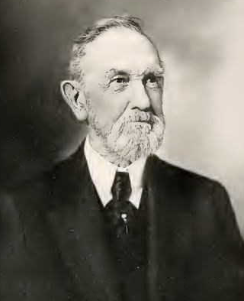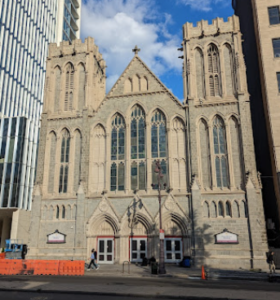Title: Contractor, surveyor
Birthdate: February 17, 1831
Death Date: April 6, 1918
Plot Location: Section 13, Lot 36

William’s lineage can be traced back to the arrival of John Grubb on a Delaware shore in 1677. He greeted William Penn, who arrived five years later on his way upriver to establish  the city of Philadelphia. John’s grandson, Emmanuel, fought in the French and Indian War and in the Revolution. His grandson, Mellin, left Grubb’s Landing, Delaware, just south of Claymont, to become a stone mason in Philadelphia. That’s where his son William was born.
the city of Philadelphia. John’s grandson, Emmanuel, fought in the French and Indian War and in the Revolution. His grandson, Mellin, left Grubb’s Landing, Delaware, just south of Claymont, to become a stone mason in Philadelphia. That’s where his son William was born.
William attended the public schools, then served a seven-year apprenticeship in the carpenter’s and builder’s trade. His mentor was John McClure, a prominent contractor. When his apprenticeship was finished, William was hired by his boss as of January 1, 1853, eventually became a partner, and remained active in the contracting business until he retired in 1876.
Family Life
There was one other reason why the first day of 1853 was a day he would never forget. He exchanged marriage vows with an Irish girl and fellow Presbyterian, Catherine Haggerty. Their children arrived in the even-numbered years: 1854, 1856, 1858, and 1860, with the last birth (from a surprise pregnancy?) in 1871.
His two oldest children were boys and both started out as builders. William W. Grubb later changed careers to be a hotel keeper and never married. Charles M. Grubb kept at it, was married with children, and retired in Ventnor City, New Jersey. The third child, Anna, was only married for 23 years before her husband died but they raised nine children in their Bryn Mawr home. It’s also where William and Catherine spent many holidays. Their fourth was Catherine Emma Grubb, who married the first of her three husbands when she was in her late 30s. The youngest, Mary Martha, married and moved out of the area.
Working Life
During his career William planned and erected many churches, public buildings, and private residences. His success led the firm to be recognized as one of the leading contractors in the city. He invested some of his wealth in the properties surrounding his home in the Fitler Square neighborhood. A question on the 1860 census asked the value of his real estate, to which he answered $10,000. By 1870 it had grown to $41,700.
In the 1880s and 1890s William listed his occupation as a surveyor, motivated more by pleasure than compensation. By the early 1900s William W. came back to live with his parents. Also living there was a niece, a grand-nephew, and a servant. Their home was on Spruce Street as it had been since city directories were first published in the early 1860s.
One of the many branches of the Grubb family tree held a reunion in 1905 where William was  featured, as reported here. He was also honored to become a member of the Carpenters Company. Philadelphia’s historic Carpenters’ Hall has been privately owned by the company to this day.
featured, as reported here. He was also honored to become a member of the Carpenters Company. Philadelphia’s historic Carpenters’ Hall has been privately owned by the company to this day.
It was the meeting place of the Carpenters’ Guild, the oldest craft guild in America, and where the First Continental Congress was held in 1774. William was elected president of the company in 1899. (One of the men who purchased the land for the building was Benjamin Loxley, who also helped build what today is called Independence Hall. He is also buried at Mount Moriah and his Notable story can be found here.)
William lost his wife Catherine to kidney disease in 1912 when she was almost 80 years old. Six  years later he met with a fatal traffic accident when he was crushed between two trolley cars at Broad and Arch Streets. His funeral service was held at Chambers-Wylie Memorial Presbyterian Church, a few blocks south on Broad Street. Two years later one of the stained glass windows in the church, shown here, was dedicated in his memory by his daughter, Catherine Grubb Matlack.
years later he met with a fatal traffic accident when he was crushed between two trolley cars at Broad and Arch Streets. His funeral service was held at Chambers-Wylie Memorial Presbyterian Church, a few blocks south on Broad Street. Two years later one of the stained glass windows in the church, shown here, was dedicated in his memory by his daughter, Catherine Grubb Matlack.
The children had their parents buried at Mount Moriah at the edge of Section 13. This  oversized ledger grave (left) covers the underground vault where lies William and wife, plus the three oldest children: William W. (1854-1918), Charles (1856-1930), and Anna (1858-1931).
oversized ledger grave (left) covers the underground vault where lies William and wife, plus the three oldest children: William W. (1854-1918), Charles (1856-1930), and Anna (1858-1931).  None of the five children had many years left to enjoy their inheritance, as reported here. The real beneficiaries of the wealth that was left behind ($5 million in today’s dollars) went to the next generation.
None of the five children had many years left to enjoy their inheritance, as reported here. The real beneficiaries of the wealth that was left behind ($5 million in today’s dollars) went to the next generation.

Support the Friends of Mount Moriah
Help us in our mission to restore and maintain the beautiful Mount Moriah Cemetery by donating to our cause or volunteering at one of our clean-up events.

